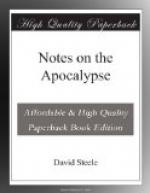20. And every island fled away, and the mountains were not found.
21. And there fell upon men a great hail out of heaven, every stone about the weight of a talent; and men blasphemed God, because of the plague of the hail; for the plague thereof was exceeding great.
Vs. 17-21.—“The seventh angel poured out his vial into the air.”—The devil is emphatically styled “the prince of the power of the air.” (Eph. ii. 2.) All the preceding vials fell upon their respective and successive objects, the several parts of the symbolic system; but this “vial of consummation” affects the whole of that system at once. The dragon, the beast, and his image, together with the false prophet,—all the “kingdoms of this world and the glory of them,” which the god of this world claimed as his own, and offered to our Lord Jesus Christ in the days of his humiliation, (Luke iv. 6, 7;)—all will be destroyed for ever. He who gave commission by a “great voice,” (v. 1,) to these angels, now that they have fulfilled his pleasure, solemnly declares his approbation,—“It is done.” The Lord Christ had solemnly sworn that “in the days of the voice of the seventh angel, when he should begin to sound, the mystery of God should be finished,” (ch. x. 6, 7.) He is faithful to his oath,—It is done. Hence, it is undeniably evident that the seventh trumpet agrees in time with the seventh vial; and it is equally evident that the events which they represent are yet future. What was obscurely intimated as following the sounding of the seventh trumpet,—“the nations were angry,—and thy wrath is come,” (ch. xi. 18,) is here amplified; for the “voices, thunders and lightnings,” are the visible and sensible tokens of the wrath of God. (Exod. xix. 16; Heb. xii. 21.) Next follows an “earthquake,” the usual symbol of revolution; but this one is without parallel. An earthquake followed the opening of the sixth seal, (ch. vi. 12;) when paganism was overthrown in the Roman empire by Constantine, and another earthquake marked the close of the second woe, (ch. xi. 13,) when “the tenth part of the city fell:” but this concussion is “so mighty and so great” as to “divide the great city into three parts,” or rival factions: next, “the cities of the nations fell,”—revolted from their wonted allegiance, and “great Babylon came in remembrance before God,” who seemed to have forgotten both her and his saints whom she had so long and so cruelly persecuted. At the fall of Rome pagan, mountains and islands were only “moved out of their places,” (ch. vi. 14;) but at the fall of Rome papal, “every island fled away, and the mountains were not found;”—the former indicating transition, the latter utter destruction.—The “fall of hail” is to be viewed as accompanying, not following, the fall of cities, flight of islands and mountains. As hail-stones are symbolical of divine judgments, and as there may be allusion here to another of the




